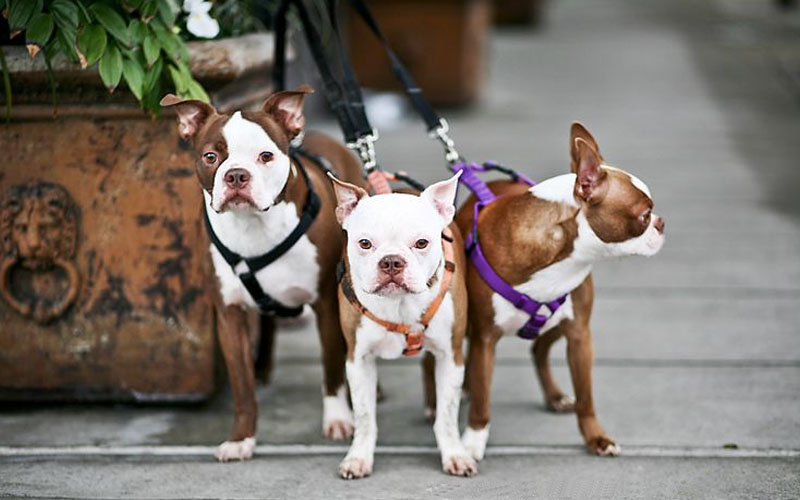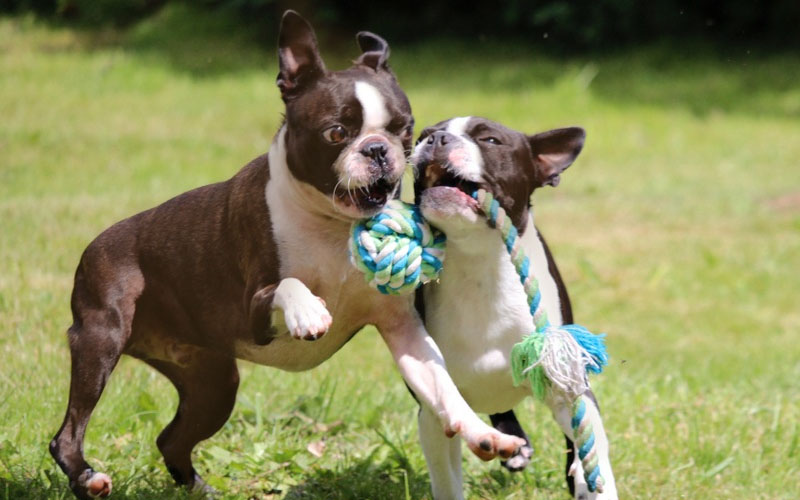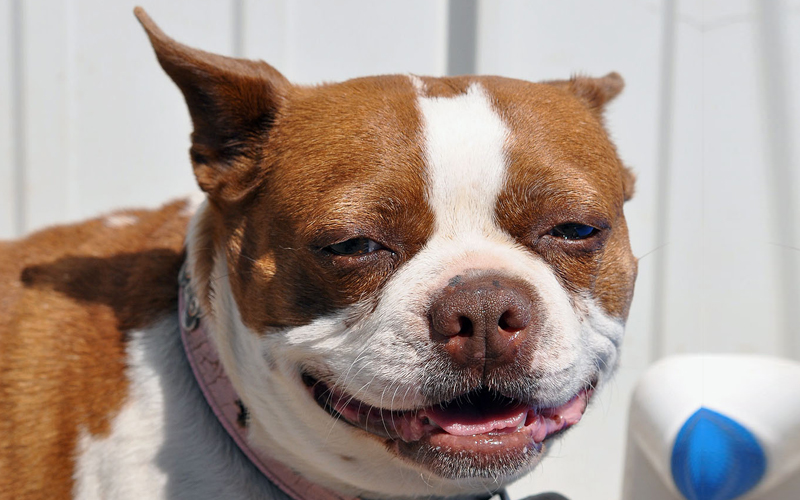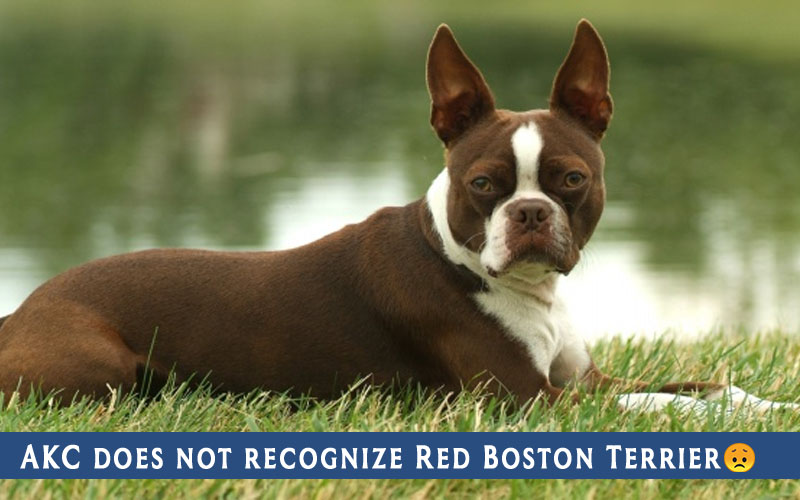Having a pup at home is a tremendous yet permanent source of happiness but a great responsibility too. You have a baby in your home that craves your attention, affection, love, and care almost throughout life.
However, this duty never lets you feel tired as small things you do for a pup is not a duty but an everlasting spring of pleasure.
Though all dog owners are sensitive about the health and wellbeing of their pets, Red Boston Terrier owners are responsive to the fitness for their pups like a fish out of water.
Well, this is all because of some myths circulating the internet and unrecognition of Red Boston Dogs by the AKC (American Kennel Club).
Do you want to know each and everything about your rare dog breed with amazing fur color and unique characteristics?
You will also know why AKC (American Kennel Club) doesn’t register this very dog for shows, yet does the other dogs of the same breeds.
Table of Contents
What Do Red Boston Terrier Puppies Look Like – Recognizing Your Dog:

Boston Terrier is a dog breed with pups that don’t size much. Yes, this is a compact dog breed with a friendly attitude and a loyal yet compassionate behavior towards owners.
They’re great family dogs, able to live in the hustle and bustle of the city and have a very composed attitude.
Are Boston Terriers One Person Dogs?
Boston Terrier dogs make great family pets with an affectionate and friendly attitude. They love to surround by fellows and welcome friends and family to home.
Whenever they see humans and fellow dogs, they start barking with excitement. All with this they are not aggressive.
Boston terriers are sensitive dogs
Boston terrier dogs consider you their universe and are sensitive towards you. You cannot treat this sweet sensitive breed of dogs with harsh methods. They attuned to your emotions and if you show aversiveness, the pup cannot do good.
Red Boston terriers are sensitive dogs and understand the owner’s mood hence they are one-person dogs, very protective for elderlies. However, they are friendly and outgoing with standoffish polite humans.
Recognizing the Red and white Boston terrier puppies is not very difficult, thanks to their amazingly colored liver-toned coat. Here is what you need to know about Boston Terrier Puppies’ identification.
Facial Chops:
Facial chops include fur, skull and face, eyes, ears, nose, muzzle, jaws.
Fur:
Boston Terrier breed is a vast breed, covering dogs with different coat colors. Famous tones the fur can comprise are tuxedo, seal, brindle, evenly marked with white tone.
So, you can say, the dog has two-toned hair; one of them is black while the other one can be of colors related to the parents.
However, when it comes to Liver Boston Terriers, these dogs have a very different tone of fur.
Skull and Face:
The skull is flat yet square with no wrinkles on it like a pug, though they are of similar size with him.
Their head is identical to its predecessors, who were tough and bigger but as loyal and intelligent as this one. Their cheeks are flat, brows abrupt, and has a well-defined top.
Eyes:
Boston Terrier Eyes are square-shaped, tucked in skull, with outside corners in line with cheeks when you see from the front.
Blue eyes or traces of blue are not recommended because Boston terries have very beautiful yet sensitive and somewhat protruding eyes. Hence, they need extreme protection.
When your dog is staring at you, the eyes will appear like set in the square-shaped skull and making a cornered line with cheeks.
Ears:
The ears of your Red Terrier are erecting like cats, yet they are small in size, placed on the corners of the skull, naturally, making the shape of the head as square as possible.
Nose:
Unlike other terrier dogs, red Boston has a Dudley nose with well-defined nostrils, having a line in between. The color of the nose is black, and it is broad in size.
Muzzle:
Muzzle, if you don’t know, is the overall mouth of your terrier dog. This dog is a civilian and citizen; hence its muzzle is short and deep, shaped like a square.
There are no wrinkles on the muzzles, and it is almost parallel to the skull.
Jaws:
Just like muzzle, the jaw is also the same; square with regular but short teeth. The bit is undershot; however, chops are of good depth.
The lips are wide enough to cover overall teeth and tongue when the mouth is closed.
Weight and Size:

Check for your dog’s weight and size to make sure it is a red Boston Terrier:
Weight:
Red Boston Terriers have striking square appearance; hence their legs are short, balancing the shortness of the body. They are compact dogs, never grow to a large size.
Size:
They healthily weigh between 15 and 25 pounds. Though overfeeding can increase the weight of your dog, that would be an obese dog and not a healthy one.
The temperament of the Red Boston Pup:

In temperament, the qualities you will find are intelligence, friendliness, and compassion:
Intelligence:
Generally, the dogs appear as compact, weighing between 15 to 20 pounds with alert expressions on the face.
Such an easy-to-read appearance shows their inner intelligence as Dogs of Boston are extremely intelligent, according to AKC (American Kennel Club).
Friendliness:
As Red Terriers are named after a city name, it is enough evidence to show that they can be excellent urban pets.
Active in the temperament and intelligent in aptitude, these Boston dogs in red are friendlier species.
You can take them for a walk and expect their interest in everyone like people walking past, sitting beside, or moving, etc. – they are people-oriented breeds.
Boston Terrier Attitude:
Boston Terriers, attitude wise, are very smart, gentle, affectionate, and have cool temperament and that’s why known as American gentleman. However, without proper training they can behave stubborn.
Can Boston Terriers Be Left Alone?
Red Boston terriers are understanding companions and though they love their owner’s company yet they can stay alone for a maximum 8 hours. However, the place should be made safe with a dog safety gate. Make sure to keep all stuff around as Boston can suffer their bladder when left alone.
Compassion:
Red Fire Boston Terrier is sharing ancestorship with bull-type breeds, and somehow, their facial appearance shows that.
Same like their predecessors, the red terriers are very compassionate and loyal towards their owners. They are fun-loving and will always be ready to lick you and love you.
Before moving to fun facts of the breed, you must know some health issues and caring related tips of this exclusive Boston dog with red fur.
What Are Red Boston Terrier Health Problems – Taking Care with Home Remedies:

Red Boston Dogs are mostly misinterpreted due to their rare fur-coat. Many myths and rumors have also leaked about them, especially relevant to health issues.
Myth: Boston Terriers with red fur, are prone to have serious health issues unlike other dogs of the breed.
Truth: Red and white Boston terrier puppies are as healthier as any other standard Boston Terrier, the difference is just in the fur, not in the overall immunity of the dogs.
They are incredibly loving and playful pooches and love to have you and their favorite gadgets around.
Red Bostons, they live healthy and prosperous lives like other dog breeds and are prone to having similar diseases as others from the same race.
We also have rare blue-colored Boston terrier dogs:
See More: Accessories For Pets
Blue Boston Terrier
Traditional black Boston dilute is termed as Blue Boston Terrier. It happens because of the mutation in the chromosome pool of Boston terriers that instead of appearing black, their coat comes in shades of blue, grey, or silver.
Red Boston Terrier
You can find red Boston Terrier dog in different darker or lighter shades of red. Red Bostons have red nose along with a red coat and hazel eyes.
Boston dog’s red color is actually liver color. However, liver-colored Boston is not recognized by kennel club and Boston Terrier Club of America.
Red Boston Terrier Health Issues:
No medical problems have ever been related to red Boston Terrier dogs specifically.
Like other general dogs, some health issues in all Boston terrier dogs are cherry eye, cataracts, deafness, luxating patella, allergies, and sensitive digestive systems.
Boston Terrier Red Eyes:

Boston terrier red eyes can be a sign of chronic issues like corneal ulcers or simple ones like dry eyes.
However, keratoconjunctivitis sicca is common in the breed.
It happens due to lack of tear formation. If not treated, it can cause blindness and the risk is high among older Bostons.
Red Boston Cherry Eye:
Cherry Red Eye is another common canines’ issue and problem that occurs on the white side of the eye. A cherry-like ball starts to appear in the eye.
However, it can quickly be resolved with home remedies. Just press the cherry-eye a bit; it will disappear.
Cataracts:
As said, Boston canines from terrier breed are prone to develop eye issues; Cataract is among them. It relates to blindness and is an inherited problem from the ancestors.
There are two types of Cataract issues that can occur on different stages of dog life; one in early-age while the other that develops later. Regular vet checkups are recommended to avoid it.
Digestive Issues:

Red Boston small and adult pups can easily develop stomach related issues such as diarrhea or bleeding with each bout. This is a common issue.
You should look forward to curing it at very early stages by bringing change in the food type and quantity. However, see a vet if you find the problem is getting worse.
Allergies:

Allergies, once again, related to eyes and skin are likely to occur in the red terrier Boston dogs. However, skin-related issues such as itching can also be found commonly in these canines.
If you find your pup with excessive mucus in the eye, watery-eye, or rubbing his body against furniture, see a doctor.
Deafness:

This problem directly re-counts at the senior years of your Boston dog. Yes, all Boston Terriers can develop deafness in their older age.
However, the process can be slowed down or wholly avoided by comprehensive care and measures such as using medications and regular vet checkups.
Luxating Patella:
Red Boston Terriers are active dogs. They love walking, running, and jumping around the home as well as on the locations nearby.
Due to their active living, the Luxating patella is a knee-related issue, has more tendency to occur in these canines. You need to take proper measures before taking your Bostons out for a walk.
Rare, Uncommon and Misunderstood Facts About Red Boston Pups:

Red Boston Pups are incredibly loving and fun pups to have in your home. Never let false information on the internet pertinent to these so-loving canines mislead you.
They are just like other pooches that will love you more than anything in this world.
Also, Red Boston mongrels are recognized as comedian dogs because of their funny and funky face features; the long ears, square face, and a pair of big eyes.
Here some fun facts you should know when deciding to bring your Boston Terrier Red pooch home.
Red Boston Terriers Do Not Have Red Coat:
Name, recognition, and rarity; all happens due to the different colors of the coat, mostly identified as Red.
However, you will be amazed to know that the fur is not red but a similar tone, more like liver-color in Boston Terrier Pooches.
That’s why, most of the time, they are also stated as Liver Boston Terrier. They have a red nose and hazel or gold-colored eyes.
Red Boston Pooch has Huge Demand in Market:
Despite all the myths and rumors about this loving and innocent creature on the internet, the dog is in good demand in the market.
Due to being a demanded breed, Red Boston Terriers fetch a high market price. The underlying reason behind this is, of course, their fur, that’s liver-red.
You better hurry to buy a Boston terrier with red because prices are likely to expand more.
Red Boston Terriers Have Five Growth Stages:
From birth to eighteen months, the growth of Boston Terrier Dogs is divided into 5 different stages each with a different name.
Such as:
- Neonatal Stage:
Till two weeks from birth.
- Transitional stage:
From two weeks for four weeks.
- Socialization stage:
Fourth week to twelfth week (you can start socializing your red boston terrier dog with other fellow humans and dogs in this stage.)
- Ranking Stage:
From three months to six months. (it is the growing time of your Boston terrier in which he is also developing his habits.
- Adolescence Stage:
It starts at sixth month and lasts till eighteenth month.
No Health Issues Specified with the Different Color of Their Coat:
These dogs look different from their siblings because of the coat or fur. We usually don’t find dogs in liver-colored hair.
It’s so rare to see, and due to this, people have developed so many misconceptions about their health.
Many people believe that the red color in the hair makes Red and white Boston terrier puppies more like to catch ailments, that’s wrong.
Boston Terrier Health Facts – No Health Issues Specified with The Different Color of Their Coat:
However, some health issues can occur due to breeders’ unhygienic attitude. They try to deform RBDs for short face and domed head.
By doing so, health problems risk increase regarding breathing, eye, join, and heart diseases, epilepsy, and cancer, etc.
They Share Ancestorship with Bulldog and English Terrier:

They Share Ancestorship with Bulldog and English Terrier and look similar to Tuxedo dog:
Like parents, despite being small, red Boston terriers are sturdy and muscular. Due to this, Boston terriers look-alike tuxedo dog with the white markings on their shiny coat.
Their ears also have always erected rare shape.
AKC Does Not Recognize Red Coat Terrier Dogs:
AKC, the American Kennel Club, is a registering organization of Purebred dogs. This club doesn’t recognize Red Boston Terrier as a registered part of canine clubs or purebred just like coydogs.
Most people think that fur is the reason behind this, but that’s not the case. There are many factors based on which AKC registers a pup.
Red Coat having terrier dogs remain unable to fulfill that criterion.
Why Does AKC Not Recognize Red Boston Terrier?

Well, AKC (American Kennel Club) has some standards based on which a dog is registered with the club. He can be disqualified for minor reasons such as a Dudley nose.
However, this is nothing to do with the health of the pooch. Even a non-AKC-recognized dog is able to live a healthy and sound life.
For more information: You can check the Boston Terrier standards of registration by AKC.
Boston terrier mix
Boston Terrier mixes are dogs that come as a result of cross between a purebred terrier dog and another purebred of another breed.
A Boston terrier mix is a designer breed with a mix of characteristics inherited from parents. So, you can find red Boston dogs with unique features.
Boston Terrier vs. French Bulldog
Comparing Boston terrier and French bulldogs, we find major differences in distinctive ears like a bat that kept erected on their square-shaped head.
However, Boston terriers have pointed ears on their round head.
Brindle Boston Terrier dogs are registered as brindle black or brindle seal. In some breeds you see a hint of brindle while others have exact brindle patterns on coats. Brindle coat patterns and shades can vary.
Boston Terrier Pug mix
The mix cross between Boston Terrier and pug is called Bugg. Boston Terrier Pug mix gives intelligent, affectionate, spunky, and cute and inherited some super traits from parents. Other names for bug are Boston Terrier Pug or Pugin.
Boston Terrier Pitbull mix
Boston Terrier and Pitbull both dogs have terrier lineage in their family tree however due to unfair associations, both dogs differ a lot apart from size.
However, Boston Terrier Pitbull mix is affectionate, playful, and loyal as both parent breeds are.
Bottom Line:
From the whole discussion, we can get an idea that Red Boston Terrier or Liver Boston Terrier dogs are healthy dogs, and they will be an excellent addition to your family.
They are so loving, can be trained easily, and are highly intelligent compact dogs with no risk of diseases.
Therefore, get this pet with complete confidence and never let the false online information about them mislead you.
Any more myths you know about red Boston dogs, let us know in the comment section below and don’t forget to check more information on rare dogs, at inspire uplift blog.

